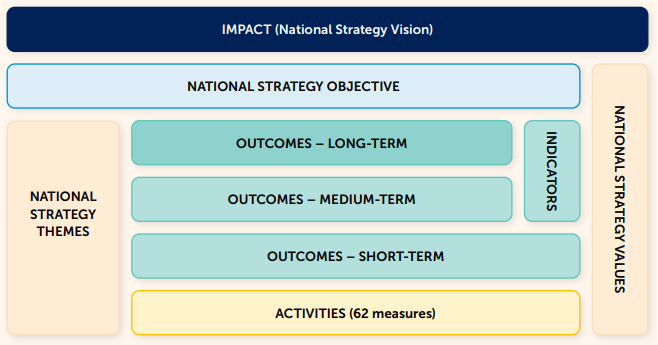How the Framework underpins the National Strategy
The National Strategy is incorporated into all levels of the Framework’s structure.
Elements of the Framework

Text alternative for the above image
A diagram showing the structure of the National Strategy with levels: impact, objective, long-, medium-, and short-term outcomes, indicators, activities, themes, and values.
End of alternative text
Vision
The National Strategy’s vision sits over all components of the Framework:
“All children and young people are protected and safe from sexual abuse. Victims and survivors are supported and empowered.”
Objective
The Framework’s short-, medium- and long-term outcomes feed into the National Strategy’s objective:
“The National Strategy will reduce the risk, extent and impact of child sexual abuse and related harms in Australia.”
Themes
Each activity under the First Action Plans has been assigned to one of the 5 main themes. The Framework’s short and medium-term outcomes are mapped to these themes:
- Awareness raising, education and building child safe cultures
- Supporting and empowering victims and survivors
- Enhancing national approaches to children who have displayed harmful sexual behaviours
- Offending prevention and intervention
- Improving the evidence base
Values
The National Strategy’s values guide all work under the Framework:
- Child safety is everyone’s responsibility. Australian, state and territory governments, organisations, industry, communities, families, kin, carers and individuals all have a role to play.
- The views and experiences of victims and survivors are a priority, and their needs shape our efforts.
- Children and young people’s voices and views, experiences and participation are central to the decisions we make.
- We hear and value the diverse views and experiences of all Australians. The work we do to prevent and respond to child sexual abuse is:
- culturally safe
- developmentally and age appropriate
- trauma-informed
- accessible and meets diverse needs and circumstances.
- Evidence, data, research and evaluation informs our policies, programs and reforms.
